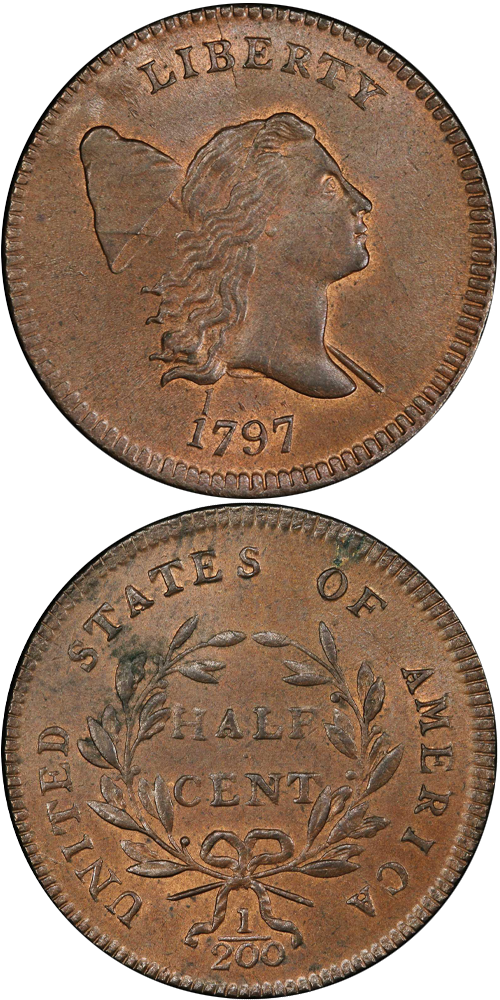1797 Liberty Cap Half Cent
1 Above 1
This obverse, in its only known pairing, is readily identifiable by the presence of an errant 1 punched entirely above the first digit 1 in the date. Close inspection with a loupe reveals several dot-like die defects in the field above the digits 797, and there is also a more prominent die scratch through the bottom of the cap. On the reverse, a single leaf is at the top of each branch in the wreath, five berries on the left branch, three on the right branch; there is a berry on the left side of the bow, but not on the right side. There is a die scratch above the left corner of the letter I in UNITED that slants up to the right. The same die as that used for the 1797 C-2 variety.
Cohen-1 is the only die marriage of the 1 Above 1, Plain Edge Guide Book variety of the 1797 half cent.
The famed 1 Above 1 die error is perhaps the boldest die punching error in the entire U.S. coinage series. The top 1 is thinner and lacks bottom serifs, indicating at least some attempt to efface it, but no great effort was put into its removal. Ed. Frossard, writing in 1879, seems to have mistaken it for a die break, perhaps incredulous that such a remarkable error could have been left in the die. Most specimens of this variety are struck over cut-down Talbot, Allum & Lee (T.A.L.) tokens, Breen's 1c attribution. Though this example shows no evidence of any undertype, this does not necessarily indicate a virgin planchet was used. In fact, Manley asserts that most, if not all of the coins that Breen attributes as 1a (rolled copper planchet stock) are simply examples that show no evidence of the T.A.L. undertype. (The extremely rare and unconfirmed B-1b attribution corresponds to planchet stock derived from cut down spoiled cents.) st of this issue, it is interesting that the present example weighs appreciably less at 76.4 grains.
C-1 is the most available 1797 half cent die marriage and the only one corresponding to the 1 Above 1, Plain Edge Guide Book variety. As such, examples are eagerly sought among type collectors. The surviving population of high-grade coins is generous by the standards of the Liberty Cap series, but most are in EF and AU grades. Indeed, while this variety is relatively commonplace in circulated grades, it is rare in Mint State.
The example to the left was sold by Stack's Bowers Galleries in the D. Brent Pogue Part III Auction, where it realized $223,250.






